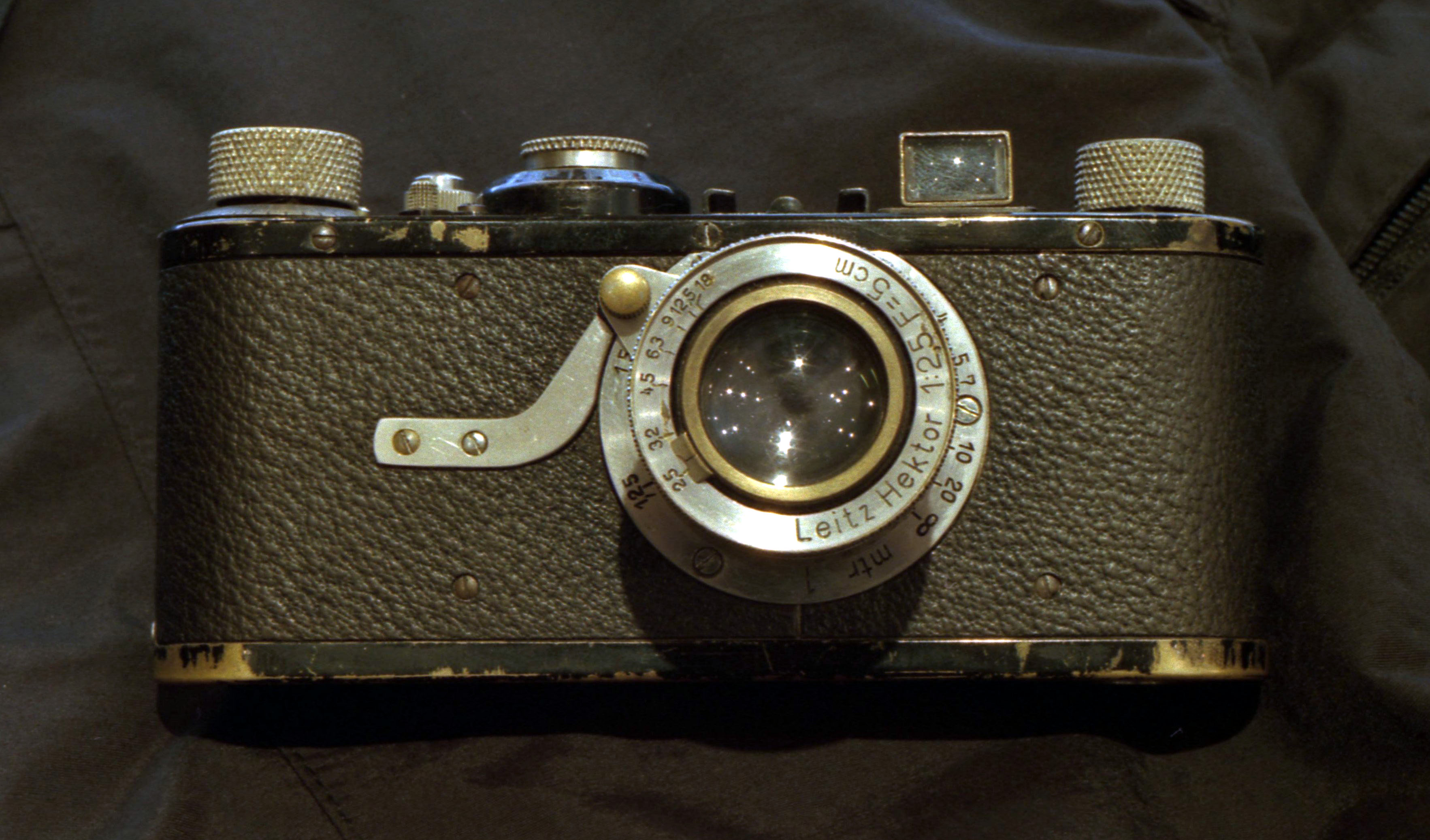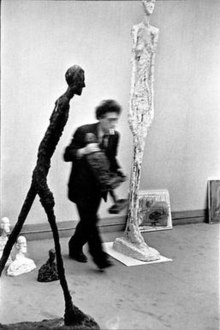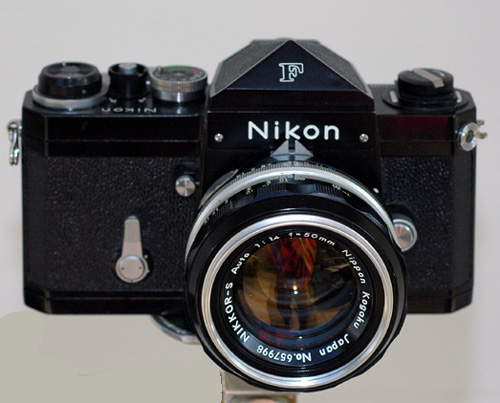Wartime Photography
The horrors of war and its aftermath were bought home to the population through journalistic and documentary stories. The First World War (1914 – 1918) years focussed photographers mainly on the devastation left after battles. However, improving film and better lenses meant that the true horrors of battle could be photographed in graphic detail. The positive lifestyle impact of pre-war photography suddenly changed. Photography as a tool for historical and optimistic cultural pursuit suddenly expressed a negative force. War photography, in its most pessimistic and stark representations, opened up a new era of realism in image-making.

The 'Leica I' (1925) - the first compact camera was immediately popular. (Wikipedia).
The development of the 35mm format took place during the First World War. It was not until 1925 that the first 35mm camera went into production. The Leica I (for Leitz camera), was the first in that compact format and was immediately popular. Many compact cameras of a similar type followed from other manufacturers. Widespread use of the new 35mm film format contributed to improved photographic techniques during the inter-war years. During the 1930s, Henri Cartier-Bresson and other photographers began to use the small, 35mm cameras. The more compact format enabled them to easily capture realistic images of life as it occurred, rather than through staged shots.
The stark realism of early war photography intensified in World War II. Journalistic photography after 1939 was more objective than previous times. Improved techniques, cameras and film made reporting more immediate, immersed in day-to-day battle action. War photographers found themselves in the line of fire rather than reporting on the aftermath. Consequently photographers were killed in conflicts during WWII (and in subsequent wars to the current day) – strong testimony to the immediacy of photography in the new era. See ‘War photographers – a special report’ – The Guardian Newspaper [Beware – graphic images] 
The sharpness of photographic responsibility and realism came out in wartime photography (despite a thriving propaganda machine on all sides). As a result photography perhaps gave the impression of being an absolute representation of truth and reality – which it is not. Photography, like all art, is open to interpretation and to the manipulation of the viewer’s perception.
Pin-up models and the ‘sweetheart back-home’ photos were also encouraged by the war machine. This perhaps helped to raise the awareness of images in the public mind. After the war popular publications exhibited a growing use of photography and imagery.
Post war photography
The 35mm film format and equipment gained increasing popularity from the mid-1940s. Other file and camera formats continued too. Large format photography continued to be popular with professional photographers. Larger format film was retained for larger pictures and greater detail – medium format photography continued for specific work too. It was the 35mm that won the public hearts. In the heady enthusiasm for fun and stylish living of the 1950s 35mm film complemented lifestyle choices. Photojournalism was growing fast and the documentary story was penetrating popular culture. The era of mass photography was upon the world.

The Asahi Optical Company, later known for the popular 'Pentax' marque, released the Asahiflex IIb in 1954 - The first Japanese SLR using 35mm film
Henri Cartier-Bresson expressed the concept of the “Decisive Moment” in his influential book, “Images à la Sauvette” (1952). This is when visual elements in the shot combine with the reality of the moment in the context of the shot. The combination, if successful, is visually pleasing and captures the essence of the moment in a meaningful and satisfying way.

Sculptor Alberto Giacometti by Henri Cartier-Bresson From Wikipedia
Cartier-Bresson said in his book:
“Photography is the simultaneous recognition, in a fraction of a second, of the significance of an event as well as of a precise organization of forms which gives that event its proper expression.”
This quote has been interpreted widely, but is undoubtedly influential. Emphasis on the importance and reality of the moment reflected social issues of the time. The 1950s and 1960s were a time of realism  verses idealism
verses idealism  . The developing power of image-making was testament to at least part of that debate. The public face of those ideas were important because of the growing power of images in the media.
. The developing power of image-making was testament to at least part of that debate. The public face of those ideas were important because of the growing power of images in the media.
Style, fashion, personal freedoms and new money were pushed hard by the media during the 1950s. The stirring of the ‘glamour’ photography revolution helped too. There are few references to ‘glamour’ in the 1950s. Nevertheless, this was the decade of the public pin-up and movie star culture. Marilyn Munroe and a whole host of stars from the period graced the front pages of the new image-based magazines. Photographs were enjoying public appeal like never before.

First issue of Playboy (with Marilyn Munroe), December 1953 - On Wikipedia
Colour photography was beginning to make an impact too. Despite that, black and white photography remained predominant. Camera equipment was cheaper than ever. Most photographers and enthusiasts stayed with black and white because it was cheaper than colour – requiring less processing.
 Photokonnexion tips by email
Photokonnexion tips by emailIf you enjoyed this article please sign up for our
Tips by email service.
Find out
more…
Can you write? Of course you can!We would love to have your articles or tips posted on our site.
Find out more…
Write for Photokonnexion.
By Damon Guy (author and Photokonnexion editor)

Damon Guy (Netkonnexion)
Damon is a writer-photog and editor of this site. He has run some major websites, a computing department and a digital image library. He started out as a trained teacher and now runs training for digital photographers.
See also:
Editors ‘Bio’.
![]()
![]() was one of the first SLRs to provide Through-The-Lens exposure metering (TTL metering). The camera takes a light reading through the lens.The user can then make an exposure decision by matching the meter readouts. The camera was not an automatic camera in its early forms. Pentax continued its development. In 1972 the international release of the Electro-Spotmatic outside of Japan became the Aperture-priority, electronic, automatic SLR. By today’s standard the capability of this automation was limited. Nevertheless it heralded an on-going race toward general automation.
was one of the first SLRs to provide Through-The-Lens exposure metering (TTL metering). The camera takes a light reading through the lens.The user can then make an exposure decision by matching the meter readouts. The camera was not an automatic camera in its early forms. Pentax continued its development. In 1972 the international release of the Electro-Spotmatic outside of Japan became the Aperture-priority, electronic, automatic SLR. By today’s standard the capability of this automation was limited. Nevertheless it heralded an on-going race toward general automation.  Photokonnexion tips by email
Photokonnexion tips by email












